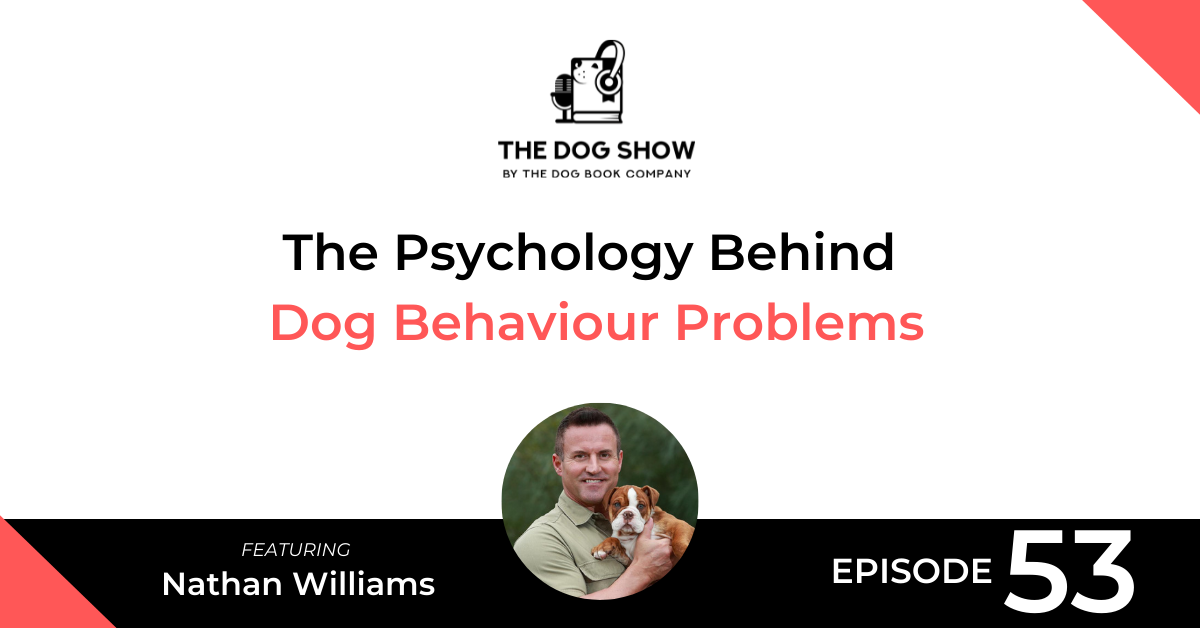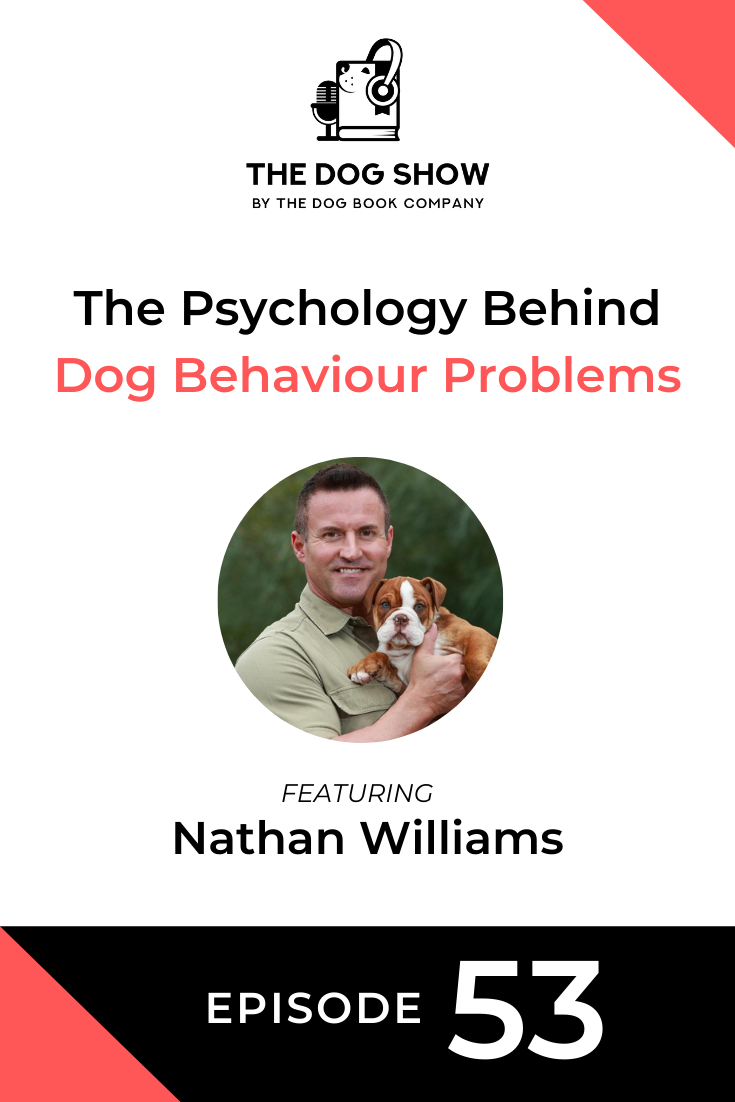
Ever wondered what causes dog behaviour problems?
In this episode of The Dog Show, featuring Nathan Williams, we discuss the psychology behind dog behaviour problems and how you can overcome them.
Nathan is Australia’s leading expert in dog psychology and behavioural issues. He is regularly featured in the media to discuss all topics related to dog behaviour, donates his time working with problematic dogs in animal shelters, and works tirelessly to dispel myths surrounding so-called ‘vicious’ breeds such as Pit Bulls and Bull Mastiffs.
Find out more about Nathan here:
Listen
Watch
Read
Will: This episode of “The Dog Show” features Nathan Williams. Nathan is Australia’s leading expert in dog psychology and behavioral issues. He is regularly featured in the media to discuss all topics related to dog behavior, donates his time working with problematic dogs in animal shelters, and works tirelessly to dispel myths surrounding so-called vicious breeds such as pit bulls and bull mastiffs. In the interview, we discussed the psychology behind dog behavior problems, and how you can overcome them. Nathan, welcome to “The Dog Show” today. Thanks for coming on.
Nathan: Thanks for having me.
Will: Yeah, I’m looking forward to having a chat today. You’ve got an extensive history in dog psychology and dog training. So, really excited to hear some insights about what we’re talking about today. But do want to kick things off by just telling me how it all happened. Why did you become a dog trainer in the first place?
Nathan: I became a dog behavior specialist kind of through necessity. Because the world right now as we see it is kind of more confused than ever when it comes to dogs. But we’re meant to, kind of, be evolving. So, when people at home are trying to do the right thing, that’s like, the more they’re trying to do the right thing, the more wrong they’re getting it. And that’s what I’ve found throughout the term of the work I’ve been doing is that people are struggling more they try. So, it basically taught me from the very beginning that there’s a problem in the teachings itself, not in the owner itself. Because the term is there’s no such thing as a bad dog, there’s only a bad owner, which couldn’t be further from the truth. I haven’t met a bad owner. I’ve met 1,000 owners who are trying to do the right thing, but they just don’t know how to, right? But they’ve had three trainers there that are trying to teach them. And the rule is what works for one dog might not work for another dog.
But then there’s rules. And these rules exist to work with all dogs. And it’s kind of like kids, like kids have different needs, but if you get them to follow the same kind of rules and you work out how to accomplish that, then they’re all good. So, at the beginning, I felt like I had no choice but to do it. Because if I don’t do it, especially at the beginning, there was dogs being euthanized for these behavioral problems. And knowing what I know and not doing it, I wouldn’t be able to live with myself. So, I kind of had no choice but to help. So, now I’m motivated by multiple things, but one of them is necessity. The other one’s an easy one, it’s love and passion. You know, the love of dogs and being able to help people as well, because a lot of people get into this industry because they don’t like people. They love dogs. But that’s probably where I’m very different. Because I love people, especially dog people. So, this is kind of like a people industry with dogs in it.
Will: Yeah, well, you got to be…I mean, you’re dealing with the owners, right? So, you got to be a people person, so.
Nathan: Yeah. Absolutely.
Will: Yeah, unfortunately, there’s so many dogs that are euthanized globally, even today, even with all of the education pieces that are out there. So, it’s a great cause to be looking after.
Nathan: Absolutely.
Will: So, I believe part of your journey was you had a pit bull mix or something at one point that had some behavioral issues. Is that right? And that, kind of, spurred you on?
Nathan: Well, yeah. I used to work with horses when I was a lot younger, and I had a…it was a pit bull, it was a pure pit bull.
Will: Okay. Yeah.
Nathan: And he ended up suffering from separation anxiety, and just quite intense anxiety to the point where he’s hurting himself to try and escape, to try and get to me if I was at home. Realizing what I was doing with him was nearly the opposite of what I was doing with horses. And then as soon as I realized that, I started interacting with him in a very different way. And in three days, he made a complete turnaround. And then I just saw something that seemed blatantly obvious to me that no one seems to see. So, then I’ve kind of learned about that more and honed those skills and knowledge over the last 18 years to get to the point I’m at now where we can help any dog. So, any dog no matter how aggressive, no matter how anxious, there’s always a way, it’s just knowing the way to do it. Because I keep hearing, “That dog can’t be helped.” And all I actually hear is they don’t know how to do it. But I prove every day that if you know how to, you can accomplish it. And we’re starting a video of that, too. So, we’re going to be releasing some evidence of that very shortly.
Will: Okay, kind of stepping around how that actually happens. But before I, kind of, probe you about that, why don’t we take a step back and talk about the implications of behavior problems? So, we’re kind of talking about dog behavior problems, and what are the implications for owners, like, how does it come to fruition for an owner when a dog has a behavioral issue?
Nathan: Man, for people who don’t go through it, it’s nearly impossible to understand it because it can be really severe. I’ve had people that have taken months off work because they’re so afraid to leave their dog because the dog is harming itself. I’ve got people that are afraid to have people visit them. They’re afraid to walk their dog, of their dog attacking somebody. And these people and dogs are all innocent. You know, it’s not like they’re mistreating a dog and it’s caused this problem, it’s like the only thing they’re guilty of is loving their dog and not knowing what to do. And then the dog gets caught in that and is just massively confused. And just getting all the wrong information and just more confusion as time goes on. But then where I’m lucky, I get a chance to, kind of, get in there and, kind of, neaten everything and simplify it for the owner and tidy everything up and have the dog, like, just intensely loved, controlled, and calmed.
Will: Yeah, [inaudible 00:06:50]…
Nathan: But from the owner’s perspective, the stuff they go through, sleepless nights and being attacked by their own dog, and worried about the dog attacking, and just worried about the dog all day when they’re at work. And this can go on for years. I’ve had clients that have dealt with stuff like this with one dog for 12 years. And then come in and get sorted out that day. They’re like, “Oh, if I knew about this 12 years ago.” So, you can try and imagine what it looks like from that person’s perspective that they went through 12 years of stress and drama and even trauma and then finding out they could fix it 12 years ago, had they’re known.
Will: Yeah, well, I mean, a dog is meant to bring joy to your life, right? And you’re meant to bring joy to a dog’s life. And the situation you’re explaining is the opposite of that. So, no one wants to be in that situation.
Nathan: A lot of people think that because they’ve had a good dog, they think that what they did created them. But most people, they’ve got a good dog just out of chance because it’s kind of like a classroom full of kids, you can have 30 kids in there, but if you could go in and go, “Okay, I want to teach two of those kids,” you know, you could go in there and watch them and go, “Well, those two looks super easy, I’m going to pick those two.” And then working with them, you could be, “Oh, this is so easy.” But that’s not the work I do. I go in there and pick the worst two and work with those. So, a lot of people accidentally get the good two, you know, but the unfortunates, they…And sometimes I say it’s a blessing in a really good disguise because sometimes it becomes a beautiful thing. You know, like I get people that have…they’re, kind of, shutdown in life, in general. They don’t stand up for themselves, they let everyone bully them, and they got this dog that’s, kind of, pushing them around.
And through the teachings, I get them to, kind of, step up and make things happen and then start to change a person’s attitude. And they’re not telling me it changes the way they live their life, you know, they started to function a bit differently. And turns out, they needed that dog, they needed that experience for them in their lives to, kind of, progress. Because a lot of people, kind of, get stuck. And sometimes problems like this hidden really well can, kind of, get you out of a rut. And again, that’s another blessing that I have, that I get the opportunity to help people, kind of, get out of those ruts or get dogs that are giving the owner anxiety when the owner’s already suffering from anxiety. We come in and do the work with the dog, the dog’s so calm, it helps the owner get rid of their anxiety, so then the dog does become that what it was meant to be in the first place.
Because you’re right, dogs are meant to be, like, our loving companion that brings joy and love and, if anything, more peace and stuff to our life. But unfortunately, some people don’t get dealt that card. But I think it’s on all of us to, kind of, look outside the box and go, “There’s got to be a better way.” And that’s what I’m here to teach.
Will: It’s interesting that you pointed out, I guess the metaphor used was the classroom with the two bad dogs and the rest of the dogs that may just be…you might naively just go into that relationship and it’s a bit easier for that owner. There’s actually some really amazing inspirational stories of owners adopting dogs from shelters that have behavioral issues and going on a transformative journey with them. And so as you mentioned, it transforms the owner’s life as well as the dog’s life and it’s quite empowering.
Nathan: Yeah. Because when you get to witness it, it’s a beautiful thing to see. And there’s actually a documentary, “Champions,” I don’t know if you’ve seen that. It’s about Michael Vick’s dogs that people used for dogfighting. And I can’t remember how many but it was, like, hundreds of dogs that were taken. They were used for dogfighting, ended up going to loving homes, and the majority of them, again, not only did the dogs come good, and get a loving home, and like that alone is such a beautiful story, but the people that took them in, it changed them at the core in such a good way. And everyone was involved in it was beautiful. So, that documentary “Champions” is worth watching.
Will: “Champions.” That sounds great. I’m gonna look it up once we get off the call. Okay. So, assuming most people would understand what the common behavioral problems are, like your biting, anxiety, aggression, these kind of things. Let’s go right back to the beginning, where do you believe that these problems…what’s the root cause of these problems?
Nathan: This is beautiful. This is perfect. Because this is what people need to know. You know, because people always trying to address the result of the problem, not the core. So, here’s how it works. Dogs learn mainly in one of two ways. They either learn to receive or demand, right? So, if the dog’s laying in its bed…well, actually, let me give you this analogy. An owner is at home, they’ve got a puppy, and they go, you know, I’m gonna take two weeks off to spend with this puppy. This puppy is so cute, but I’m busy working. And I don’t want you to bother me while I’m working. I just need this time. But the puppy is kinda let to do whatever the puppy wants, right? And the puppy comes over to the owner, and the owner is like, “Not now, not now,” and keeps working away. And the puppy is like, oh, and goes and lays in his bed. The owner is like, “Okay, I finished up. Now I’m going to come over and smother you with affection.” Now, what that looks like from the dog’s perspective, if I try and tell you what to do, that didn’t really work. But if I just lay in my bed, love just comes to me. That’s awesome. Then they accidentally raise a relaxed dog. So, what I do when I come to someone’s house, I set that up so that happens deliberately, and there’s no confusion.
But here’s how it goes the other way. And this is what mainly happens. So, the owner is working away, but the puppy comes over, jumps up, pet me, pet me, pet me, interact with me, love me, love me. The owner goes, oh, and pick the dog up, puts a dog on top of him, and gives the dog exactly what the dog wants. So, the dog goes, okay, so the deal is to have love and affection, I have to tell you what to do. Then you’ll notice that dog licks, that dog jumps up, then that dog mouths. Now, when a dog licks, mouths, and jumps up, the chance of them biting [inaudible 00:13:49] brain forward because it programs the brain to control and demand and force things to happen. So, when they feel overwhelmed, they can then use that same methodology to control but it’s that times 10, which means biting. And that’s normally where it comes from. Same with barking, that if I’m not getting what I want, I’ll use different methods to get what I want because for things to work, I have to tell you what to do. But the dog that’s receiving, someone comes to the front door, I’m ready, and that dog just chilled out, you know, because that dog knows for me to have love and affection when someone comes, I just lay here and they come to me, right?
A classic example of that will be a greyhound. They’re very socially intelligent dogs. They pretty much do that anyway. They’re like, why would I go over to you when I can just lay here? And that’s where they’re socially intelligent. But most dogs, they kind of need more of our leadership and guidance to go look, this is how it’s meant to be, I come and get you to do things, you don’t get me to do things. I lead and guide you, I teach you, and I love you more than anything in the world kind of thing, and just this very calm, relaxed affection. But what most people do by accident is they set the dog up to fail without knowing, again, not the owner’s fault. So, the dog comes in, does a lap. Then, when the dog’s going, okay, I’ll tell you what to do, okay, now I’m going to give you a fetch, the dog gets the ball, brings it back, gets the ball, brings it back, now the dog becomes possessive and controlling, using its eyes, not its nose. But this is where it starts to become a lot more complicated. And I don’t know how deeply you want to get into the psychology of it.
But I can say things that kind of freak people out, but it’s the truth. So, for example, it’s not my opinion that fetch is bad for dogs, right? But when I say that to most people, they go, “Hey, hang on a minute. No, dogs love fetch.” Well, this is the common misconception. So, what happens? So, let’s say a golden retriever is the great example. If you go duck hunting and take a golden retriever, how would you say that dog finds the duck when it gets shot down? What does it use?
Will: Its scent. Like, its smell, I imagine. I don’t know.
Nathan: Yeah, yeah, because it can’t see it falling in reeds. So, it has to use the nose. So, that’s part one. So, when you’re doing fetch with a dog, they use their eyes because a piece of plastic doesn’t have that smell. Now, keep in mind, the dog’s brain, 60% of it is dedicated to scent, they’re meant to function off smell, right? So, that would be a natural thing for a dog to do, sniff it out, get it, and then accomplish it, bring it back, it’s over. Here’s the duck, we’re done. That owner wouldn’t pick that duck up and throw it again. Because that dog would be going, “Hey, hey, what the hell?” So, because that is what retrieving looks like, and that gives the dog a sense of accomplishment, it’s finished, I can relax now. But if that’s never-ending, it makes a dog insane.
So, what we do, we teach your dog to use its eyes, ignore the nose, which means the brain won’t work properly. Because I work with dogs every day that chase cars. And then I get some people go, “Oh, that’s prey drive.” How is a car prey? Because the dog’s meant to use his nose. And there’s no cars driving around smelling like rabbits or anything. And the whole prey drive thing with dogs is a bit of a myth as well. Dogs haven’t chased prey for a very long time. They eat from a bowl and we’re meant to teach them to be more like that and not chase stuff because you don’t want them chasing stuff. Because you get people going, “I do fetch but my dog chases birds and my dog chases skateboards and cars and blah, blah.” And I go, “Yeah, you’re getting a dog to chase, program the brain to react to something it sees and now the dog is doing just what you’ve trained. But you don’t want it, so think what you’re training for.
If they say exercise, go, “Cool, just walk your dog.” Because if you walk your dog every day, your dog will be very healthy. You got a good diet, walk every day, healthy. That dog doesn’t need to run. That’s another myth. I’m like, yeah, let them have a run at the park and stuff. But you don’t want to train them to react, use their mouth, be controlling, and do it again and again and again and again and again with no ending in sight. Because when they do that…Bristol University tested the blood and saliva of dogs doing fetch, and at different levels they all release cortisol. And cortisol being a stress hormone, which means we look at it and we go, “Oh, look, they look like they’re having fun.” They’re not. They’re stressed. But I can guarantee that any dog would love to just hang out with you, get a massage from you. Because that’s one of the main things I teach people to do. You know, when they’re massaging a dog, right, the dog’s eyes are real heavy, they’re going, “Wow, I’ve never seen this dog so calm.” I go, “That’s because you’ve been massaging for the last 10 minutes.” That’s gonna have that effect, right?
And it’s so obvious sometimes but we just don’t see it. But then they’re going, “Ooh,” smacking the dog around and getting the dog to do tug of war, revving the dog up. One of my most interesting emails I received once was gold, actually, I had to read it back to the client. They said in the email, “I get my dog to do fetch, we do tug of war. I put my dog next to my bike and we sprint. Then we do flyball, we do all these games stuff. But for some reason, my dog won’t relax.” And I said, “Do you mind if I read that back to you?” I read it back to him. And they go, “Oh.” I said, “What part of that trains the dog to be what you want? You want the dog to be relaxed, what part of that teaches the dog to be relaxed?” They go, “Well, nothing, it’s the opposite.” I go, “That’s exactly why you’ve got what you’ve got.”
But again, not their fault. You don’t see it when you’re in it. That’s the problem. When I explain it, it seems obvious, and you can see it from the outside. But being in it, it’s really hard. And that’s why when I explain it to them, they go, “Oh,” and they feel silly and, “I feel like I should have known.” And I go, “No, you’re not meant to know, you’re going off what everyone’s been taught for the last 100 years.” It’s been saturated into us from when we were little kids. Because if I asked you, Will, if a dog wags its tail, what does it mean?
Will: Yeah, I’m assuming, actually sometimes happy but sometimes anxious, depending on the situation.
Nathan: So, if I [crosstalk 00:20:48]
Will: But all the things you’ve been saying about fetch and stuff before, I mean, this is all like truth bombs to me as well, so.
Nathan: It happens. I get that every day twice a day. So, think about this, the tail, when it hangs, the muscle at the base of the tail is relaxed. But when the dog is tense, it pulls the tail up. So, even when a dog is stimulated, it comes up. And if it wags kind of like this, then that’s not anxiety, that’s stimulated and a bit tense. But when dog…the tail is up, super tense, super fast, that’s overstimulated, that is anxious. So, you’re one of the rare people that say anxiety because nearly everyone just says happy. But you can watch videos on YouTube of dogs fighting each other, you’ll see their tails going ballistic. And they’re obviously not happy.
So, the only real way to tell or get an understanding of where a dog is at mentally, it’s always the eyes. I work with dogs that they’re going to attack and the tail is hanging down. Okay, some dogs, the tail is up over their back, they’re about to attack, meaning you can’t really read a dog by its tail. The eyes always tell the truth, you’ll see it in the eyes. But then you’ve got to be able to know how to read the eyes of a dog. And I don’t expect the average person to be able to know that. And that’s why my aim is to teach people how to get it right in the first place. They don’t have to worry about reading the eyes. They don’t have to worry about biting or barking or anything like that. They’ll know how to raise their dog, having everything beautiful and calm, so much love and affection all the time, being able to go anywhere, do everything, and everyone just having normality. Normality is what I call it.
Will: But I guess…
Nathan: A lot of people call…
Will: Sorry to cut you off. I guess what you’re talking about, though, is if every dog owner follows the best practice that you’ve discussed in terms of showing leadership and laying the foundations when a puppy is young, they’ll have an enjoyable experience throughout the whole life of the dog. But because most people are a little bit…as you said they think that all of these things that we have been taught for centuries of how to interact with dogs is just naturally and subconsciously how we do that. The problems develop and then it’s, kind of, retrospectively trying to fix those problems, which is where it becomes more challenging, right?
Nathan: Well, it’s only actually been more so in just the last century. Before that, it was more natural interaction. Because if you look at the way people interact with horses, and they don’t talk to them, and they lead them and guide them, they can control a 400-kilo animal very easily. So, that kind of methodology is more what was used, like, over a century ago. And the last century, and particularly probably the last probably 30, 40 years is where it’s really started to go south because it’s become very popular to walk the dog on a harness now, that’s only the last five years. Ten years ago, nearly everyone had a collar, right? And my dog aggression cases have quadrupled in the last five years. Because when a dog pulls on a harness at another dog, the body language can come across and be threatening, the other dog could be confused. Now, if that dog’s also in a harness, they can kind of be doing that to each other. That doesn’t mean you’re going to get a problem, but it increases the rate of the problems, like, it becomes more common.
So, in a dog that has maybe some kind of anxiety or predisposition or whatever, that can be enough to kick it off. You got a super friendly dog, they’re on a harness, it doesn’t really matter. So, again, it’s not a rule. And this is the trick because people go, “No, I know five dogs who go harnesses and they’re fine.” I go, “Well, that’s not how it works.” We’ve got to look at where the problems are and know how to address those. I don’t look at where the problems aren’t, and go, “That must be the reasoning.” I look at where the problems are, know how to fix those, and go, “That’s the reasoning. That’s the truth we’re working with.” And that’s the trick. Because unfortunately, most dog trainers work with good dogs, they get the two good ones in the classroom, you know, teach them tricks. And then they think the sit, the drop, stay is the reason that dog’s behaving well. No, you just still got a good dog, hasn’t changed but just does tricks now. Hasn’t changed behavior, hasn’t changed attitude.
And that’s part of the problem is that the world of dog training has gotten, kind of, more intense and stronger. They call it positive reinforcement, and that’s just not true. I’ve never seen anyone do positive reinforcement with a dog properly. Positive reinforcement, what it really looks like is when you accomplish something, you get a dog to do it without a bribe, right? The motivation is because you’re making it happen because you’re leading and guiding the dog purely, right? And then once it’s accomplished, then something nice after unexpected, unexpected. But if you build the expectation at the beginning and show that treat as motivation, that’s now a bribe. You can’t have a reward and a bribe, it’s got to be one or the other. You can’t have positive reinforcement because that’s after, right?
So, you can only have either bribery or positive reinforcement. Because people ask me, “Do you use the method of positive reinforcement?” I go, “Yes, but probably not the way you’re thinking.” Because the way people think, the way it’s been taught, not the way it is when you look at psychology. So, psychology in humans and dogs is the same, positive reinforcement is something that comes after, unexpected, right? But if it’s the motivation that’s pushed from front, that’s bribery, right? Because if you’re going to be doing something because it’s your job, and you do really well at it, and you get something unexpected after, well, that’s rewarding. But if you’re doing it for the reward, then your motivation is that, not your purpose. Because a dog’s meant to comply because the dog believes in you, trusts you, has faith in you, and is led and guided by you, and good things come.
A dog can’t think, well, because I did that sit, therefore, I’m a good boy and that’s the reason you’re giving me that food. A dog never sees it that way. Dogs are very simple. A dog’s like, I see that food in your hand, I want that, how am I going to get it? And they put their bum on the ground and they go, oh, is that it? Yep, here you go. They go, oh, okay. So then they’ll put the ball on the ground without you even saying anything as soon as they see food, which means really that dog hasn’t learned to sit because you made it happen. That dog’s learned to sit, you know, and work out a way to manipulate you to get food off you. So, now the dog loses respect because the dog knows how to manipulate you to get what it wants. Again, does a dog tell you what to do?
Will: The demanding, as you mentioned earlier.
Nathan: Correct. It’s manipulative. So, it doesn’t seem as bad. And it looks good because we’ve been taught if a dog sits, they’re a good boy, or girl. But the whole idea is…like, I wouldn’t even teach sit. You know, I get people all the time saying, “Oh, yeah, I taught my dog to sit.” I went, “Well, you didn’t.” They go, “Yeah, I spent like two months on an off teaching sit. I did it.” And I go, “If you mean to tell me that before you did that, the dog had no idea how to sit.” They go, “No, when you put it like that,” and I go, “Yeah, I’m putting it logically and factually. I’m not trying to tease you. I’m trying to point out the fact that the dog always knew how to sit and there’s no reasoning you’re doing it.” And she goes, “But what about when you cross the road?” Just stop. The dog should stop when you stop because you’re leading, they should walk when you walk and there shouldn’t be any tension in the leash. And I teach people how to accomplish that in about 20 minutes, right?
And the dog will be like that for the rest of its life because when the dog knows how to follow, it’s very comfortable for them. Like, it’s…rewarding is probably not the right word. It’s kind of like their place. They feel really at home. They love being guided and led, but not with force. You know, so the idea of what I do takes all the force out of it. I never hold a leash with any more than my fingertips. Even a dog that’s like towed the owner down the street for five years. Because we know how to create the beginning from home, everything comes after that is beautiful.
So, today’s client, they sent their dog away for two weeks, right, to a training place. And I said to them, “Does your dog jump at the back door?” They go, “Yeah.” I go, “That’s a problem you want to fix, right?” And I said, “Well, how are they going to teach the dog to stop jumping up at your back door if they’re at a facility?” You know, because even if the dog learns not to jump on their door, it doesn’t mean the dog won’t jump on your door because dogs live by association. The dog has to learn in your presence from you in regards to, how do I enter this house? How do I feel when I…Do I enter this house respectfully, or am I demanding?” So, I’m teaching the owner to do it and it takes like two minutes and we’re done. And you just taught something in two minutes that they couldn’t teach in two weeks at all. That cost you thousands of dollars.
You know, if I could have someone pay for everything for me, I’d do my work for free because it feels like everyone that owns a dog, it’s like, they should have the right to know what to do. That’s what I feel. I feel the way it is right now, it’s very unfair to them. And it’s more unfair that they get taught the wrong thing to do, get charged for it, and it makes their life harder. One of the videos we did, I had a client that has spent $10,400 in 8 months. And then at the end of that, they were told to euthanize their dog because it’s not working, the dog’s got a problem with his brain, right? So, in about an hour-and-a-half, the dog had no problem with his brain. And I didn’t do brain surgery, meaning there wasn’t a problem with the brain. And that was done by Australia’s top veterinary behaviorist, the most qualified in Australia. That was who did that. I don’t need to name any names.
Will: That’s fine. I feel like I’ve been holding myself back because there was probably a thousand rabbit holes we could have gone down there and we’d probably end up being on this call for about three hours.
Nathan: That’s why this needs to be like weekly thing.
Will: Yeah. But like, just to, kind of, draw it back. I mean, the primary topic we wanted to cover is behavioral problems for dogs. And you’ve spoken about the psychology around that. If you had to draw it back to, kind of, one big takeaway for people today, would it be that dichotomy between the demanding and receiving, is that what you think? Or how would you summarize it?
Nathan: Massively. Massively. Well, the rule is, if everything is on your terms, you won’t have a problem. And terms means not talking. Because if you say something, it still allows choice. If the dog chooses to do it, that’s on the dog’s terms. But if you lead the dog, let’s say, for example, into its bed, you take away choice. You’re still leading and guiding and teaching, you’re not giving a treat and going, “In your bed,” and asking the dog and giving choice. And that makes a phenomenal difference. And then when you’re leading a dog in around a home, not letting the dog do whatever it wants, it’s more consistent than kinda like letting the dog do whatever it wants, giving the dog choice, and then try to control the dog on a leash on a walk. So, yeah, the simple way of putting it would be, do everything, don’t say anything. Smother your dog with the calmest affection you can. And just make everything on your terms without force.
Will: I guess what you’re saying is, it’s simple in theory, but it’s like it can be complex in application, which is why someone with, you know, almost 20 years experience like yourself, is probably very valuable to people.
Nathan: The application itself to do is super simple. The hard part is not doing everything else. So, when I work with someone, the bulk of the session is more teaching them what not to do. What to do is so simple and little and quick and clean. Because it needs to be simple for the dog. We don’t overcomplicate it, it’s not fair to the dog. So, like leading the dog in and out of the house, for example, because some people say, “Well, they won’t get out of the house when I tell the dog to get out of the house.” So, we’ll usually take the dog out.” I go, “Oh okay.” But if you do that with consistency, that’s where the moneymaker is. Because then if you do it for a month, for example, the dog will feel if they want me out, I have to go out, I don’t have choice. But that creates a calmness in the dog. It’s really cool.
I’ve given people advice, nationally, internationally, and just given simple instructions and depending on what’s happening with the dog, okay, all I want you to do is this just lead the dog out, lead the dog in, give the dog a massage, stop doing fetch, stop talking to your dog. And I’ll get a call in like three days going, “My dog has completely changed.” And at the beginning, I was like, “Really? Are you sure?” But if you look at their interactions, their interactions are the opposite of what they were doing. So, of course, it’s going to force change. Yeah.
Will: Well, Nathan, I feel like I’ve got a lot of thoughts buzzing through my head at the moment, I’ve learned a huge amount from the chat with you today. But where’s the best place people to go to find out more about you and what you’re doing? Is it the website?
Nathan: The website, which is dogbehaviorspecialist.com.au. And we’re going to be releasing videos on YouTube and stuff. And hopefully, we can do some more work together and I can share your videos, we can share ours with you guys. So, hopefully, they’ll be able to see some of our stuff through you guys as well.
Will: Yeah, perfect. Well, I’m sure everyone will look forward to checking out your videos. We’ll share all those links when we publish the episode. But thanks for coming on “The Dog Show” today.
Nathan: [crosstalk 00: 5:55] TV show called “Barking Mad.”
Will: Yes, I saw the clip for that. It’s a cool name.
Nathan: That one was like a test pilot with a different production company. We’re heading in a very different direction. So, the format will be different. But the main thing, like what we’ve talked about today, is the content. So, in that one you saw, there’s not a lot of content. It’s kind of like, “Well, that’s a nice TV show.” But we moved away from that because I want this to be more educational and entertaining, not mainly entertaining with the littlest bit of education. Because I want people to be able to watch it and make change in their lives. That’s my goal. Because if I can get everything out of here and share it with the public, I’ll die happy.
Will: Well, yeah, that’s what I’m trying to do with the podcast too. It’s all about trying to make people actually…you know, help with their dog behavior issues, or whatever else is going on their life when it comes to dogs, so.
Nathan: Awesome.
Will: Cool. Well, thanks again, Nathan.
Nathan: My pleasure, Will. Thanks for having me.
From Our Store
-
French Bulldog Coffee Table Book – The Book of Frenchies
From: AUD $59.99 Add to cart -
Dachshund Coffee Table Book – The Book of Dachshunds
From: AUD $59.99 Add to cart -
Pug Coffee Table Book – The Book of Pugs
AUD $59.99 Add to cart -
French Bulldog Notebook – A5, Hardcover, PU Leather, 100gsm Lined Pages, Bookmark (Three Colours)
AUD $34.99 Select options -
Dachshund Notebook – A5, Hardcover, PU Leather, 100gsm Lined Pages, Bookmark (Three Colours)
AUD $34.99 Select options -
Pug Notebook – A5, Hardcover, Black PU Leather, 100gsm Lined Pages, Bookmark (Three Colours)
AUD $34.99 Select options -
French Bulldog Planner – PU Leather Exterior, Metal Loose Leaf Ring Binder, 100gsm Paper (Two Colours)
AUD $64.99 Select options -
Corgi Notebook – A5, Hardcover, Black PU Leather, 100gsm Lined Pages, Bookmark (Three Colours)
AUD $34.99 Select options -
Dachshund Planner – PU Leather Exterior, Metal Loose Leaf Ring Binder, 100gsm Paper (Two Colours)
AUD $64.99 Select options -
Vizsla/Weimaraner Notebook – A5, Hardcover, PU Leather, 100gsm Lined Pages, Bookmark (Three Colours)
AUD $34.99 Select options -
Cavoodle Notebook – A5, Hardcover, Black PU Leather, 100gsm Lined Pages, Bookmark (Three Colours)
AUD $34.99 Select options -
Beagle Notebook – A5, Hardcover, PU Leather, 100gsm Lined Pages, Bookmark (Three Colours)
AUD $34.99 Select options













